| APRIL 2018 |
| Kabukiza (T˘ky˘) |  |
| Dates | 2 ~ 26 April 2018 Shigatsu ďkabuki April Grand Kabuki |
| MatinÚe |
Saig˘ to Katsu |
| Evening | |
| Casting |
Living National Treasure Onoe Kikugor˘, Living National Treasure Kataoka Nizaemon, Living National Treasure Nakamura T˘z˘, Nakamura Tokiz˘, Nakamura Kinnosuke, Kataoka Takatar˘, Ichikawa Danz˘, Band˘ Yajűr˘, Ichikawa Danz˘, Onoe Sh˘roku, Band˘ Hikosabur˘, Ichikawa Sai'nyű, Band˘ Kamez˘, Kamimura Kichiya, Kawarasaki Gonjűr˘, Ichimura Manjir˘, Nakamura Matsue, Sawamura Yoshijir˘, Kataoka Matsunosuke, Nakamura Umemaru, Band˘ Kamesabur˘ |
| Comments |
Living National Treasure Kataoka Nizaemon does his isse ichidai performance for the roles of the villains Tateba no Taheiji and Saeda Daigakunosuke in Tsuruya Nanboku IV's masterpiece "Ehon Gapp˘-ga-Tsuji".
|
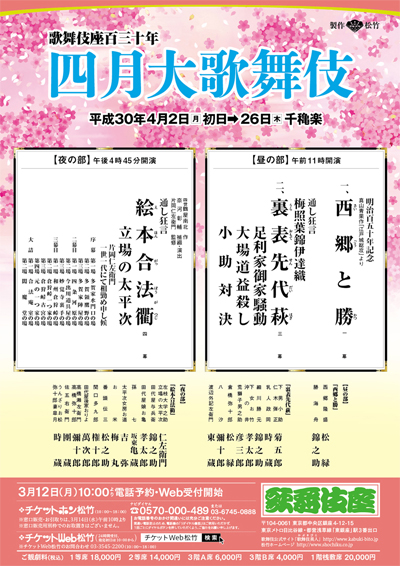 |
| Misonoza (Nagoya) |  |
| Dates | 1 ~ 25 April 2018 Kokera Otoshi Shigatsu ďkabuki Opening Ceremony April Grand Kabuki |
| MatinÚe | |
| Evening | |
| Casting |
Living National Treasure Nakamura Kichiemon, Matsumoto Haku˘, Matsumoto K˘shir˘, Nakamura Jakuemon, Nakamura Ganjir˘, Ichikawa Sadanji, Kataoka Hidetar˘, Nakamura Karoku, Nakamura Matagor˘, ďtani Tomoemon, Ichikawa Komaz˘, Nakamura Kazutar˘, Nakamura Kash˘, Nakamura Tanenosuke, Nakamura Yonekichi, Sawamura S˘nosuke, ďtani Hirotar˘, Matsumoto Kingo, Arashi Kitsusabur˘, Nakamura Jűjir˘, Nakamura Kichinoj˘ |
| Comments |
Opening (kokera otoshi) of the new Misonoza with the shűmei of Matsumoto Haku˘ II and Matsumoto K˘shir˘ X.
|
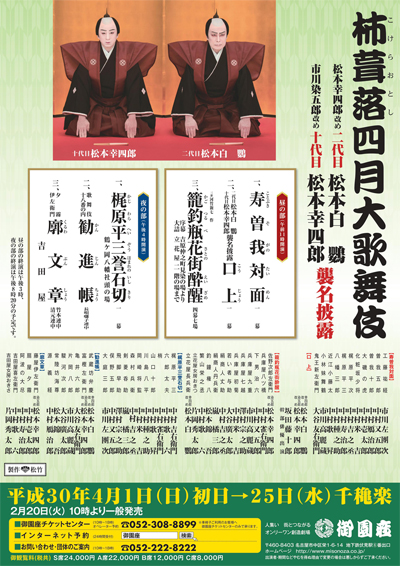 |
| Kanamaruza (Konpira) |
| Dates | 7 ~ 22 April 2018 Shikoku Konpira Kabuki ďshibai Shikoku Konpira Kabuki Grand Theatre |
| MatinÚe | |
| Evening |
Yoshitsune Senbon Zakura |
| Casting |
Nakamura Shikan, Nakamura Baigyoku, Nakamura Kaishun, Onoe Matsuya, Nakamura Kotar˘, Nakamura Hashinosuke, Nakamura Fukunosuke, Band˘ Shűch˘, Ichimura Kitsutar˘, Nakamura Baika |
| Comments |
34th edition of the Spring Kabuki performance Shikoku Konpira Kabuki ďshibai at the Kanamaruza on Shikoku Island! Nakamura Shikan VIII and two of his three sons, Nakamura Hashinosuke IV and Nakamura Fukunosuke III, celebrate their shűmei at the Kanamaruza!
|
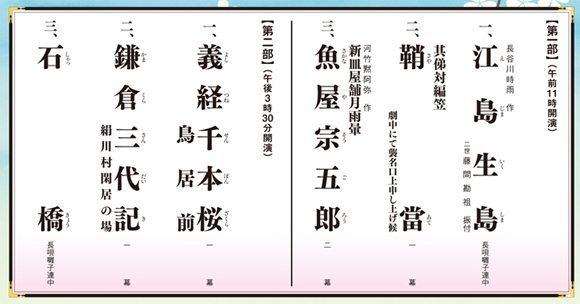 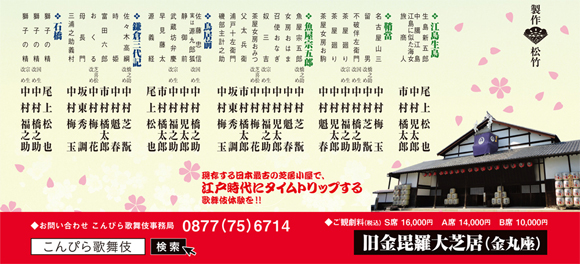 |
| Shungy˘ Special Tour | |
| Dates | 17 March ~ 5 April 2018 Shungy˘ Tokubetsu K˘en The Dawn of Spring Special Performances |
| Program |
Geidan Urashima |
| Casting |
Nakamura Kankur˘, Nakamura Shichinosuke, Nakamura Tsurumatsu |
| Comments |
The Spring Tour of the Nakamuraya guild with performances in 12 cities. The first item (geidan) in this program is a talk.
|
| Ichikawa Ebiz˘ Special Tour | |
| Dates | 1 March ~ 7 April 2018 Ichikawa Ebiz˘ Tokubetsu K˘en Ichikawa Ebiz˘ Special Performances |
| Program | |
| Casting |
Ichikawa Ebiz˘, Kataoka Ichiz˘, Ichimura Kakitsu, Ichikawa Kudanji, ďtani Hiromatsu, Katayama Kur˘emon, Kanze Yoshimasa, Miroku Tadashi, Shigeyama Ippei, Ichikawa Botan |
| Comments |
The Spring Tour of Ichikawa Ebiz˘ with performances in 23 cities. A special program mixing Kabuki, N˘ and Opera. The heir of the Naritaya guild performs in a special version of "Genji Monogatari", featuring the N˘ actors Katayama Kur˘emon X and Kanze Yoshimasa, and the Opera Tenor/Countertenor Miroku Tadashi. The script for this version of "Genji Monogatari" focuses on the story from Oborozukiyo to Suma/Akashi.
|
| Sh˘chikuza (ďsaka) |  |
| Dates | 1 ~ 25 April 2018 SűpÔ Kabuki Sekando Super Kabuki II |
| Program |
ONE PIECE |
| Casting |
Ichikawa Ennosuke, Ichikawa Udanji, Band˘ Minosuke, Onoe Ukon, Ichikawa Monnosuke, Band˘ Takesabur˘, Ichikawa Emisabur˘, Ichikawa Emiya, Ichikawa En'ya, Ichikawa Omez˘, Band˘ Shingo, Nakamura Hayato, Ichikawa Juen, Ichikawa K˘tar˘ |
| Comments |
The SűpÔ Kabuki Sekando drama "ONE PIECE", based on Oda Eiichir˘'s internationally popular manga "ONE PIECE", which got his first very successful stage adaptation by Ichikawa Ennosuke in October 2015/November 2015 at the Shinbashi Enbuj˘. It was staged one more time in the same theater in October 2017/November 2017 ... without Ichikawa Ennosuke, who broke his left arm, and could not perform the leading roles of Luffy and Hancock. He was successfully replaced by Onoe Ukon. It is staged this month in ďsaka at the Sh˘chikuza for the second time (first time in March 2016 in the same theater). Most of the actors are Kabuki actors, with 3 non-Kabuki guest actors : Hira Takehiro, Kashima Noritoshi and Asano Kazuyuki. It is almost the same cast as in 2015 (minor differences).
|
 |
|
|||
| Dates | 24 April 2018 Daisankai Kudanji no Kai Kudanji's Third Gala |
||
| Program | |||
| Casting | |||
| Comments |
3rd edition of the Kudanji no Kai in Ky˘to, which stars Ichikawa Ebiz˘'s disciple Ichikawa Kudanji. Kudanji no Kai literally means "Kudanji's Association". |
||
| Noda City Culture Center | |
| Dates | 26 April 2018 Daisankai Kudanji no Kai Kudanji's Third Gala |
| Program | |
| Casting | |
| Comments |
3rd edition of the Kudanji no Kai in Ky˘to, which stars Ichikawa Ebiz˘'s disciple Ichikawa Kudanji. Kudanji no Kai literally means "Kudanji's Association". |
| Makuhari Messe (Chiba) |
| Dates | 28 ~ 29 April 2018 Ch˘kabuki Ultra-Kabuki |
| Program |
Tsumoru Omoi Hana no Kaomise |
| Casting | |
| Comments |
The world of Kabuki and the world of otaku collide for the second time in Kabuki history! Resulting from this spectacular collision, a new genre, the Ch˘kabuki (literally Ultra-Kabuki), was born in 2016 [more details]. Nakamura Shid˘ shares the stage with the virtual 3D creature Hatsune Miku. They perform "together" in a newly-created Ch˘kabuki drama. It is staged at the Makuhari Messe as part of the Niconico Ch˘kaigi 2018 event, an important yearly event for the otaku tribes. |
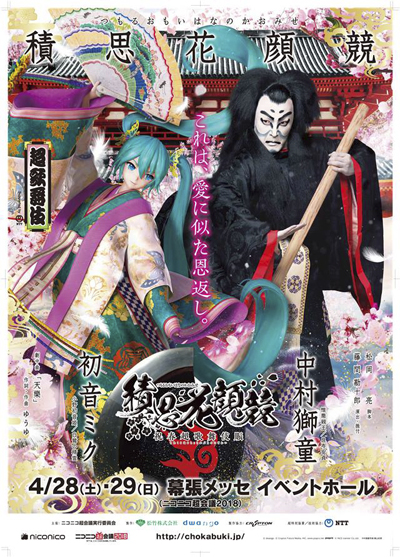 |
|
|
| Contact | Main | Top | Updates | Actors | Plays | Playwrights | Programs | Links | FAQ | Glossary | Chronology | Illustrations | Prints | Characters | Derivatives | Theaters | Coming soon | News |